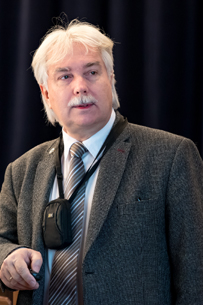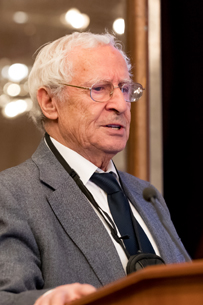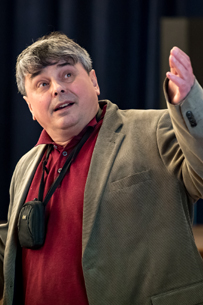Nuclear physics today and tomorrow
News, 07 February 2020
The 51st meeting of the Programme Advisory Committee for Nuclear Physics was held on 30 – 31 January in the International Conference Hall chaired by M. Lewitowicz. He reported on the implementation of the recommendations of the previous PAC meeting. JINR Vice-Director M. Itkis delivered information on the Resolution of the 126th session of the JINR Scientific Council (September 2019) and on the decisions of the JINR Committee of Plenipotentiaries (November 2019).
Recommendations of the 51st PAC NP meeting are available via the link
The report on research activities under the theme “Investigations of Neutron Nuclear Interactions and Properties of the Neutron: status and prospects” was made by E. Lychagin.
A. Doroshkevich reported on the new project “Modernization of the EG-5 accelerator and development of its experimental infrastructure”.
The report by P. Zarubin presented the proposal for opening a new project
“BECQUEREL-2”.
Two reports were devoted to the status of the Superheavy Element Factory of the Laboratory of Nuclear Reactions. They were made by V. Semin (accelerator issues) and V. Utyonkov (first experiments at the beam and prospects for the synthesis of superheavy elements).
The development of research on multinucleon transfer reactions was reported on by A. Yeremin.
JINR young scientists made poster presentations on their research on the PAC fields. The best authors were A. Kuznetsova who won the first place, E. Gazeeva and L. Shlattauer (shared the second place).
Scientific reports at the meeting were presented by V. Sargsyan (“Fusion reactions in nuclear astrophysics”) and S. Zeynalov (“Prompt neutron investigation in nuclear fission induced by resonance neutrons”).
Comments of participants of the meeting
 Professor Marek Lewitowicz, PAC Chairman: “One of the important themes discussed at the present meeting is the status of the Superheavy Element Factory. This theme has been the focus of our attention since the DRIBs-3 mega-project has been launched and the creation of a new accelerator complex and new facilities has started. Of course, we see that considerable progress has been achieved: at the last meeting, we already noted that we had achieved the design parameters in terms of accelerating efficiency and the beam intensity, and experiments already started. We are looking forward to the next experiments on the synthesis of new elements, on the further study of those elements we already know.
Professor Marek Lewitowicz, PAC Chairman: “One of the important themes discussed at the present meeting is the status of the Superheavy Element Factory. This theme has been the focus of our attention since the DRIBs-3 mega-project has been launched and the creation of a new accelerator complex and new facilities has started. Of course, we see that considerable progress has been achieved: at the last meeting, we already noted that we had achieved the design parameters in terms of accelerating efficiency and the beam intensity, and experiments already started. We are looking forward to the next experiments on the synthesis of new elements, on the further study of those elements we already know.
The topics we are discussing today and have discussed at the previous meeting cover the whole field of nuclear physics studied in the Institute, including nuclear physics with neutrons and the discussion of its prospects has continued today. Along with setting the priorities of the Seven-Year Plan, we are concerned about the prospects of the Institute’s development beyond it. I would like to highlight that we discuss some topics jointly with experts of other PACs. Especially with the Committee for Particle Physics. We successfully held such a joint meeting to discuss the development of the neutrino programme at the Institute a year ago. It is a new format for our work, and there were few meetings of the kind so far. It is crucially important as far as there are studies that we may attribute to nuclear physics, neutron physics, and particle physics. I believe that this idea deserves to be continued.”
 Professor Mikhail Itkis, JINR Vice-Director: “At today’s meeting, discussions of nuclear physics with neutrons and studies in the Laboratory of Nuclear Reactions, new facilities and ideas got further development at the meeting. As for neutron nuclear physics, there are many tasks, and facilities are out of date, in fact. In the agenda of the present meeting, it is decided what facilities demand modernization. It includes also the EG-5 electrostatic generator at which it will be possible to obtain good results for both the nuclear power industry and fundamental physics. And, of course, we discuss the use of the IBR-2 not only for the studies on condensed matters but for nuclear physics as well. It sets interesting tasks, and they may be competitive.
Professor Mikhail Itkis, JINR Vice-Director: “At today’s meeting, discussions of nuclear physics with neutrons and studies in the Laboratory of Nuclear Reactions, new facilities and ideas got further development at the meeting. As for neutron nuclear physics, there are many tasks, and facilities are out of date, in fact. In the agenda of the present meeting, it is decided what facilities demand modernization. It includes also the EG-5 electrostatic generator at which it will be possible to obtain good results for both the nuclear power industry and fundamental physics. And, of course, we discuss the use of the IBR-2 not only for the studies on condensed matters but for nuclear physics as well. It sets interesting tasks, and they may be competitive.
Another important issue, from my point of view, is the intention to bring JINR back its positions in the field of ultracold neutrons. This idea emerged in Dubna some time ago, and we should probably cooperate with Gatchina, transfer a part of our research to the PIC reactor to revive the theme as far as it is interesting and significant.
As for the future of the Superheavy Element Factory, everything is clear: go ahead and do it as quickly as possible so that no one gets ahead of us, we should be the leaders! The accelerator is ready, tested, and now the gas-filled separator is being checked. So, everything is going according to the plan. Vladimir Utyonkov spoke about it at the meeting. Something has already been done, and we hope that we will be the leaders in the synthesis of the next elements. The collaboration with our colleagues from Oak Ridge continues, they produce the material for our future experiments. Test experiments will be carried out using the already familiar element 115 that was first synthesized here. However, we should show that we can produce 50 or 100 times more atoms of a superheavy element at the Factory at the same time. If we demonstrate this, then we will be able to “move” to heavier elements because the cross-section sharply drops there and a possibility of the synthesis decreases respectively. It means that the sensitivity of our new facilities should be a hundred times higher. This is what we should show now.
At the PAC meeting, we considered neutrino physics but I think we will include this important theme to the agenda of the next one because there is considerable progress in work with the detector on Lake Baikal. In fact, we have three mega-projects: NICA, SHE Factory and “Baikal-GVD”. And all of them are constant focuses of attention at PAC meetings.”
Professor Sigurd Hofmann has been involved in work of the PAC for Nuclear Physics for several years. He was a supervisor of two reports presented at the present PAC meeting. He has a long-standing cooperation with colleagues from the Laboratory of Nuclear Reactions.
“There are two important events of the Institute’s life that have been discussed at the meeting, namely the completion of the creation of the Superheavy Element Factory we have actively discussed at several PAC meetings, and the start of experiments on the synthesis of new superheavy elements. Nowadays, the first beam has been already produced at the DC-280 cyclotron. I consider our expert work at this PAC meeting both important and honorary. To give advice to our highly qualified colleagues from Dubna is a fairly challenging task.”
 Pavel Zarubin who presented the proposal for opening a new project commented on it:
Pavel Zarubin who presented the proposal for opening a new project commented on it:
“The BECQUEREL experiment at the JINR Nuclotron studies the cluster structure of light stable and radioactive isotopes. Solving these tasks, we modernized the methods of analysis and restored the production of nuclear emulsions. Basing on the results of the experiment, a doctoral thesis, six PhD dissertations were written, and several reviews were published.
As for future research, the main task of the BECQUEREL experiment is to apply the method of nuclear emulsion for the study of the rarefied baryonic matter produced in the dissociation of heavy nuclei. The layers of the nuclear emulsion irradiated at the NICA beams will be the material allowing the investigation of nuclear ensembles of unprecedented multiplicity and diversity. Solving these tasks requires considerable investments in automated and computerized microscopes, as well as improving the production technology of nuclear emulsion.”
Reports presented by young scientists at the poster session were actively discussed. The session encouraged communication between experienced experts and young researchers.
Junior Researcher Bogumił Zalewski graduated from the Gdansk University of Technology, then worked in the Heavy Ion Laboratory in Warsaw. Now, his experience in Dubna is much wider than it was in Poland.
“First, I came to Dubna for practice, and I liked it here so much that now it is the fourth year I have been participating in experimental research at the ACCULINNA-2 facility. Some materials of my PhD thesis are presented at this stand. So, we may say that I rehearse the defence of it.”
Sergey Stukalov has been taking part in research with light exotic nuclei for the second year already. The upcoming experiment will be conducted at the and of April – May.
“We will work on the experiment on the May holidays. When all this equipment is installed in the facility, many issues will become clear. Everything comes with the experience. Many issues I have learnt here were not taught at the university. I studied reactor physics and technology at the university. I knew the basics and it helped a lot. I am engaged here in experimental nuclear physics, I know in which direction I should develop. Moreover, older colleagues actively help. For example, Sergey Krupko helped a lot with the setting up of our detectors at the ACCULINNA facility…”
At the end of the meeting, the PAC members met with the JINR Directorate, accepted proposals for the agenda of the next meeting and adopted recommendations that will be presented to the Scientific Council.
Evgeny Molchanov, JINR Weekly Newspaper
Photos by Elena Puzynina
